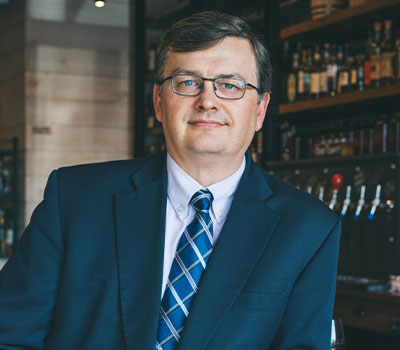

As the corporate beverage director for Max Restaurant Group, Brian Mitchell oversees ten restaurants in Connecticut, Massachusetts and Florida. As such, his job has always included juggling many different needs, but this is the first year he found himself chopping mushrooms on the line and building plexiglass barriers in his garage for Max Downtown, the group’s flagship restaurant, while working on ways to keep the beverages flowing.
How did Max Downtown adapt to the pandemic?
Well, in the group, we did a ton of takeout and a ton of outside dining, but because Max Downtown is in the city, we didn’t have a patio or any space that we could move out to easily. We didn’t reopen the restaurant until September. And Hartford, quite honestly, is still empty. It’s not a very big city to begin with, but the three or four big office buildings that are there are pretty much completely empty. So the corporate business and the flow of people for lunch didn’t happen. Every week, we do some specialty things—barbecue, and pre-made dinner packs. We have Cryovac-packed steaks that we’ll put in the boxes with chiller packs and some sides and usually a bottle of wine or a to-go cocktail. It’s not easy, but because we are a group, we do have access to what we’ve learned in the other restaurants with regard to packaging, labels and everything else.
How has this affected wine sales?
Overall sales are down, so the wine sales are down from a volume point of view. In Connecticut, we are allowed to sell bottles of wine, cocktails, liquor or beer to go as long as it’s in combination with a meal sale. But because the consumer was used to going to the local wine shop to pick up a bottle of wine and then getting a meal, they had to make an adjustment to understanding that we actually could sell product. And we had to come up with a new pricing strategy. I figured out that, if I did a fifty-percent discount off of my wine-list price, it’s not totally equal to retail, but it’s pretty close to it.
What drove the popularity of South American reds like Santa Carolina Maipo Reserva Cabernet Sauvignon and Alto Limay Patagonia Pinot Noir #2 this year?
I think it’s because it’s cabernet and pinot noir; I mean, it wouldn’t really matter, almost, what the cabernet or the pinot noir was. People buy cabernet and pinot noir at entry-level prices, and those are the entry-level by-the-glasses. But [those wines] tend to be there in the hierarchy because the quality at the price is much better compared to what I can get from, say, California. Unfortunately, the stuff that I get from California or even Washington often has the taste of oak chips and poor integration of acid that’s been dumped into it to balance out the sweetness that’s been dumped into it. They’re just so manipulated that I just don’t often find anything that I can really stand behind. So the Santa Carolina works for me. I get a little complaint once in a while because Chilean wines tend to have a little bit of an herbal edge to them. Some people are used to that California sweet, manipulated style. And (Santa Carolina) is not that style, but it definitely works better with food.
Yet you’re doing fine with big-name California cabernets as well.
We’re a steakhouse. They want a California cab. Stag’s Leap and Duckhorn, they’ve always been strong sellers for us. I think you can put Jordan Cabernet into that category, as well. Stag’s Leap Artemis, it’s a well-known label. It’s been around forever, and people gravitate towards that at our place, because they’re comfortable with it, and they know that there’s good price comparison. And Duckhorn, I think, has benefited because they’ve gotten some really good press the last couple years. The company has matured from being a single estate with all the subsidiary brands, and also now puts a lot more focus on their general marketing. It was always respected; now, they’re pushing it out into more corporate settings and more national accounts.
And, in our case at least, we have a lot of people who are willing to spend a few dollars more because they want to help us out. There’s a little bit of a sympathy-buy there.
How has your job changed?
I mean, you want to talk about changes to your world…as a beverage director, I’ve done everything from building plexiglass dividers for the bar in my garage to washing dishes and prepping food. I was never a restaurant manager, but I’ve been covering manager shifts when people have to go out because of COVID or whatnot. When we were shut down in April–May, and we were actually paying people with PPP money, we wanted to keep them engaged, so I built a website with an entire training platform and did lots of videos, interviewed winemakers, and put it all together on our website. So my role has expanded to cover anything and everything—learning to be a web developer and a videographer and an interviewer, but also chopping mushrooms and washing pots and whatever else.
Nobody can afford (a sommelier) right now. That’s what’s called a “luxury position” in the industry right now. I actually wrote a training guide 25 years ago called Nine Sommeliers Are Better Than One because I was doing staff trainings in these restaurants where they didn’t have a sommelier, and the guys would say, “Well, I’m not a sommelier.” I’m like, “Well, yeah, you are. You’re the sommelier because you’re the person serving the wine.” And one day, there were nine of them sitting in front of me, and I said, “One, two, three, four, five, six, seven, eight, nine. Nine sommeliers are better than one sommelier. You guys can do the job.”
What is your outlook for 2021?
Well, as soon as it stops snowing, I think the outlook’s pretty promising. We’ve started to see a little bit of uptick in people coming back. In Connecticut, we’re actually pretty good as far as things like COVID vaccines go. I mean, we could definitely use more, but Connecticut has been kind of moving along. Here in Connecticut and our places in Massachusetts, we’re going into Valentine’s Day weekend, which is historically an important period of time for our sales, and we are on limited capacity with 50 percent in Connecticut and 40 percent in Mass., but we are booked on Sunday night; we’re booked on Saturday night; we’re looking at a pretty strong weekend. And then, for the rest of the year, as people start getting vaccinated and things start to lighten up, I think business will slowly come back. By the end of the year, hopefully we’ll be in a pretty good position to start recovering and recouping some of the losses that we’ve had over the last year.
is W&S’s editor at large and covers the wines of the Mediterranean and Central and Eastern Europe for the magazine.
This is a W&S web exclusive. Get access to all of our feature stories by signing up today.
















